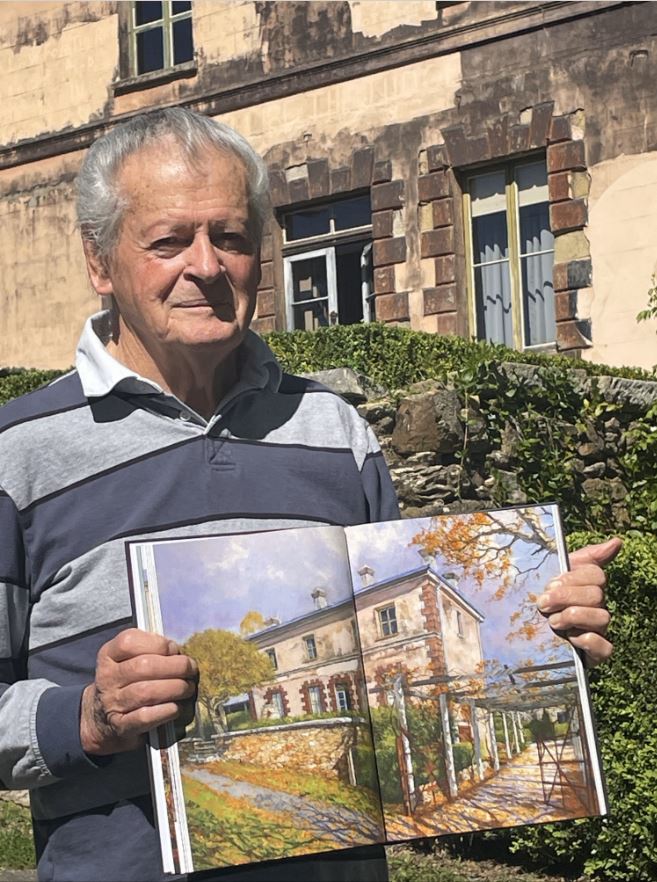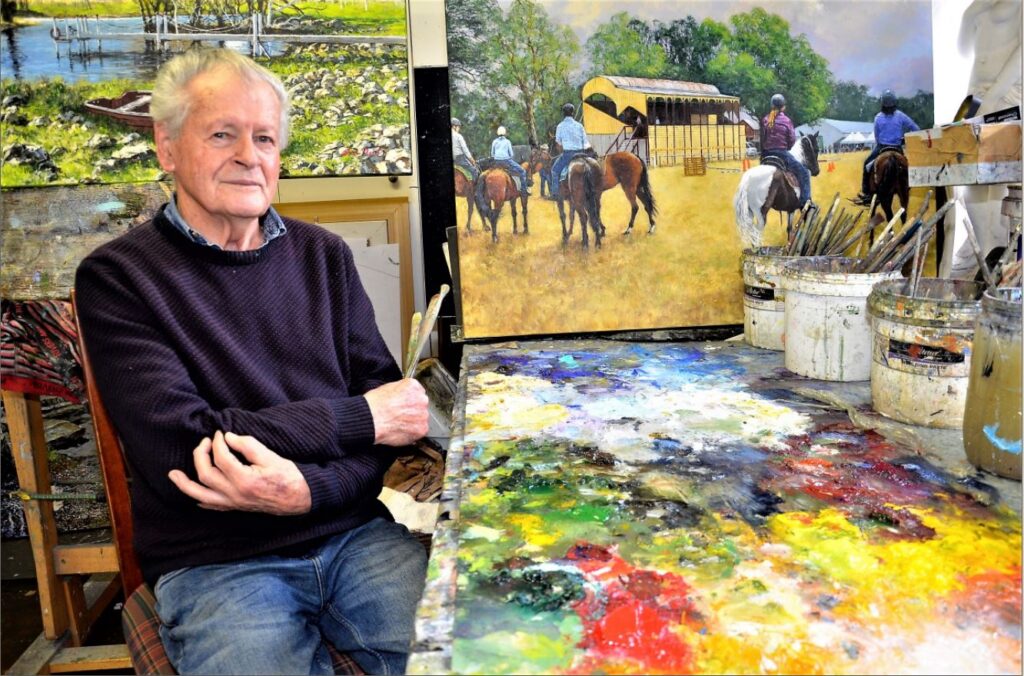October 27th, 2023Diverse landscapes, myriad towns & history

Words: Donna Kelly | Image: Narelle Groenhout
Daylesford artist Brian Nash has produced a coffee table book, The Golden Shire – Locations and
Surroundings of the Hepburn Shire.
Brian, whose large landscapes are regular winners in
art shows, said when he first moved to the region from
Melbourne 23 years ago, he was impressed with “the
various and diverse landscapes, the myriad towns and their histories”.
“You don’t often see as many small towns close
together, part of the gold rush, so that was fascinating for
me. And I wanted to leave a legacy. Some of the things I
have painted for the book have already gone. If you don’t
record these things, they can disappear.”
Brian said he had always dreamed of creating a book
and started painting and collecting his work about 12
years ago. “I have this theory that every artist should
paint where they are, the area they are in. I like painters who do that.”
The book, at 224 pages, is big, and has more than
200 paintings of more than 26 towns from the larger
ones like Daylesford and Creswick, to the tiny and often
now almost forgotten hamlets of Smokeytown and
Lawrence. Brian has also included snippets of history
which have tickled his fancy.
In the 1800s, it was decided to move the smallest
pub in Australia from Smokeytown to Allendale. But to
keep the licence, it had to remain open during the move.
Using Australian ingenuity, the pub was hoisted onto a
tray and pulled by oxen for the short move, with punters
still inside drinking their beers.
Then there is the bridge at Lawrence, built in 1900
by Sir John Monash, an engineer before he became
Australia’s most famous army general. It is the oldest
concrete bridge in Victoria, with plans afoot for restoration.
“There are a lot of incredible stories and so many
quirky places, like Radio Springs at Lyonville – the
Centre of the Universe. And people can read the book
and then go and see the places for themselves. And some
have already changed.”
Brian also thanked his book designer Emma Paine
and former Daylesford Rotary president Terri Oprean
“for doing all the technical things I can’t.”
The book is for sale at Shire information centres,
Paradise Books in Daylesford, Daylesford Trading and
directly from www.briannash.com.au It will also be for
sale at the Daylesford Art Show. Cost is $69.95.
August 4th, 2023Artists of the Central Highlands …

Daylesford’s Brian Nash has long captivated art lovers with his powerful interpretations of the world around him, particularly landscape. Right now his work, together with that of photographer Bec Walker, is part of a feature exhibition showing at the Convent Gallery. In recent days, Brian generously shared his time with journalist Eve Lamb to provide some insights into his creative process, sources of inspiration, and life as a professional artist.
Eve: How should we best describe your artistic style?
Brian: Realist, impressionist.
Eve: How did you come to art?
Brian: I didn’t come to art. It came to me. For as long as can remember I was always drawing and painting and I thought everybody could do the same.
Eve: How did you nurture your innate arts talent?
Brian: I am completely self taught, I nurtured my art through observation and practice.
Eve: Where do you do most of your art work?
Brian: Mostly in the studio although I sketch subjects as well, but I like to finish work in the studio.
Eve: Which artists have influenced your creative practice?
Brian: Quite a lot actually, but some of them are Andrew Wyeth, John Singer Sargent, Sorolla, Hans Heysen, and Edgar Degas.
Eve: Are there any other particular factors that have influenced your creative practice?
Brian: Not really but I have always been a keen observer of what is around me.
Eve: What is your media of choice?
Brian: I work in acrylic, oil, pastel and watercolour.
Eve: What is your subject matter of choice? Why so?
Brian: I am mainly a landscape painter and living here in Daylesford I find inspiration and diversity within Hepburn Shire and the Central Highlands.
Eve: Have you ever worked in any other areas besides working as an artist?
Brian: I worked in a large printing company in Melbourne for 18 years before I decided to make art my career.
Eve: What are you working on at the moment?
Brian: A series of paintings of the Hepburn Shire.
Eve: What work, goals or projects do you have in mind for the future?
Brian: I am in the process of producing a book of paintings featuring the many beautiful subjects of the Hepburn Shire. The book is called The Golden Shire and should be published by October this year; very exciting for me as I have been working on this project for over 20 years.
Eve: When you work in the studio do you like to play music and if so what is your music of choice?
Brian: I do listen to music in the studio. Mainly classical.
Eve: To date what have been your career highlights as an artist?
Brian: One of them was a painting trip to Tuscany with a group of prominent Australian artists that was followed up by an exhibition of the works in Melbourne.
Eve: Do you have any exhibitions or special arts events taking place that you would like to let others know about?
Brian: At the moment I have an exhibition at the Convent Gallery with photographer Bec Walker, that will be shown till the end of August.
Eve: What would you rate as the biggest challenges in being a professional working artist today?
Brian: The biggest challenge for me is for my type of art to be accepted by the public as there are so many different styles of art to compete with.
Eve: And, for you personally, the greatest rewards?
Brian: I think the greatest reward for any artist is to believe in what you do, in the hope that your work is appreciated now and long after you are no longer here.







